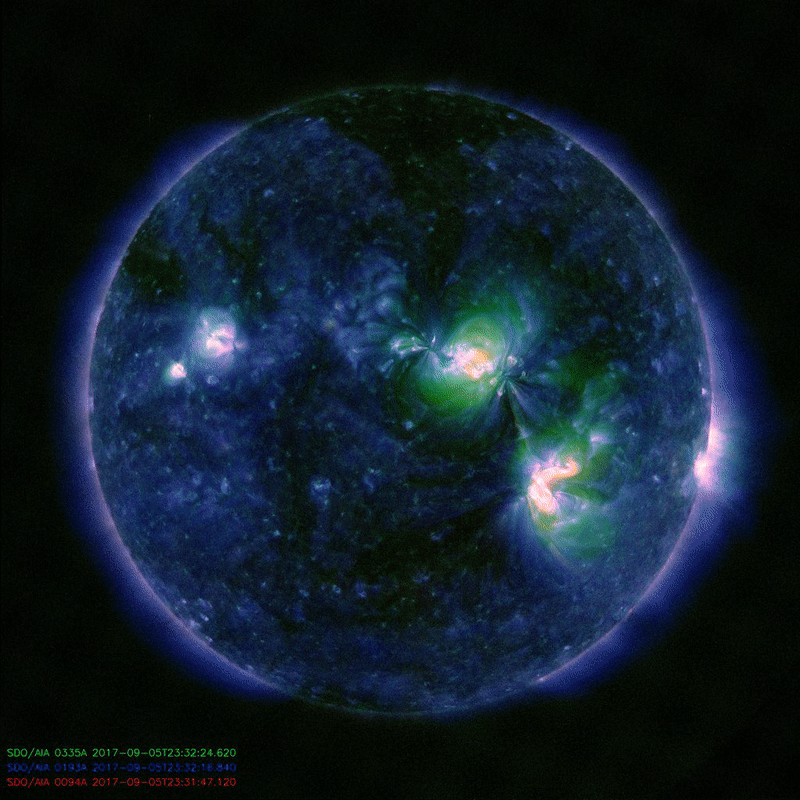
Composite video of the sun as imaged by the Solar Dynamics Observatory in three false-color, high-energy wavebands between 5 September and 7 September of this year showing the magnitude 9.3 X-class solar flare as a bright pink outburst. Link to original HD video available here and on our YouTube channel here.
What would happen if Earth were hit by a powerful solar flare? We found out in 1859 during what is known as The Carrington Event when the electric grid went dark and we found out this past September when radio and satellite communications were interrupted.
All stars, regardless of their size, mass or power output produce energy by transmuting (fusing) lighter elements into heavier elements. This process begins in all cases with the fusing of four hydrogen nuclei (protons) into one helium nucleus and continues throughout the star’s “productive lifetime”, the period during which the crush of gravity from the star’s mass is balanced by outward gas pressure. When the star’s compliment of hydrogen becomes substantially depleted to within 12% of its original value in the case of the sun, hydrogen fusion ceases, the star’s core begins to implode and heat up, igniting the helium that has built up during the star’s “normal” hydrogen fusion cycle. At this point, helium fusion begins, continuing the star’s energy production while producing carbon and oxygen as byproducts. The stars are thus, huge elemental factories, the only sources of heavier elements, the elements necessary for life.
Stars are dynamic self-regulating systems each powered by a huge, nuclear fusion reactor in their core. Considering their size and the number of variables in play, their dynamism, reliability and stability are truly remarkable. Having said that though, there is always a certain inherent instability, some stars more unstable than others. Our sun happens to be quite stable with a mild, eleven-year cycle of variability. Currently, we’re approaching solar minimum and thus we observe fewer outward manifestations of the sun’s internal activity. Observed solar activity such as sunspots, solar flares and prominences are all a measure of the sun’s internal dynamics and energy output. The more outwardly quiescent the sun is, the less active the sun is internally.
Million-degree gas produces X-rays; solar flares, short-lived and temporal, are often associated with sunspots, cooler regions of the sun’s photosphere resulting from magnetic anomalies that cause a breach in energy transmission from the solar interior; simply put, solar flares are the energy released by super-heated gas in the solar interior and are channeled via the conduit created by the magnetic breach of the solar photosphere, the upper layer of the sun. They emit energy in the visible, ultraviolet, X-ray and gamma-ray regimes of the electromagnetic spectrum. The X-rays and gamma-rays, being of the highest energy, are associated with localized, super-heated gas beneath the solar photosphere and were the cause of the subject flare.
Quite unexpectedly the sun hasn’t behaved in a manner consistent with a star approaching minimum output during its cycle of variability. On 6 September, the sun unleashed an extraordinarily powerful flare given that we’re approaching solar minimum, the most powerful flare in a decade and a flare whose magnitude was almost 10 times stronger than the previous X-class flare observed only hours earlier. The flare was so powerful that satellite and radio communications were interrupted and it took 8 hours for the earth’s ionosphere to recover from the ionization caused by the flare as demonstrated by the following image. Produced by a local university’s space weather monitoring station, secondary M-Class flares are observed interspersed over the day during the ionosphere’s recovery.

Ionospheric response vs time of the 6 September, 2017 x9.3 solar flare. Note the sharp spike associated with the X9.3 marker and the slow rise (recovery) of the ionosphere by sundown (the downward arrows on the right side of the image). Prior to sunrise, an X2.2 solar flare occurs. At night, the ionosphere is quiet as suggested by random fluctuations in its ionization levels.
Clearly, there is much we don’t understand about the sun, a middle-aged star that formed over 4.5 billion years ago along with its family of planets. It is known however that, as stars age, their variability increases; or maybe this flare is just a statistical anomaly. In any case, more study is warranted and, consistent with that directive, this summer NASA will launch humanity’s first mission to “touch the sun“, a probe whose orbit will consistently bring it to within 6.4 million kilometers of the sun’s photosphere or 10 times closer to the sun than Mercury! Unlike Icarus though, the Parker Solar Probe‘s wax won’t melt.

